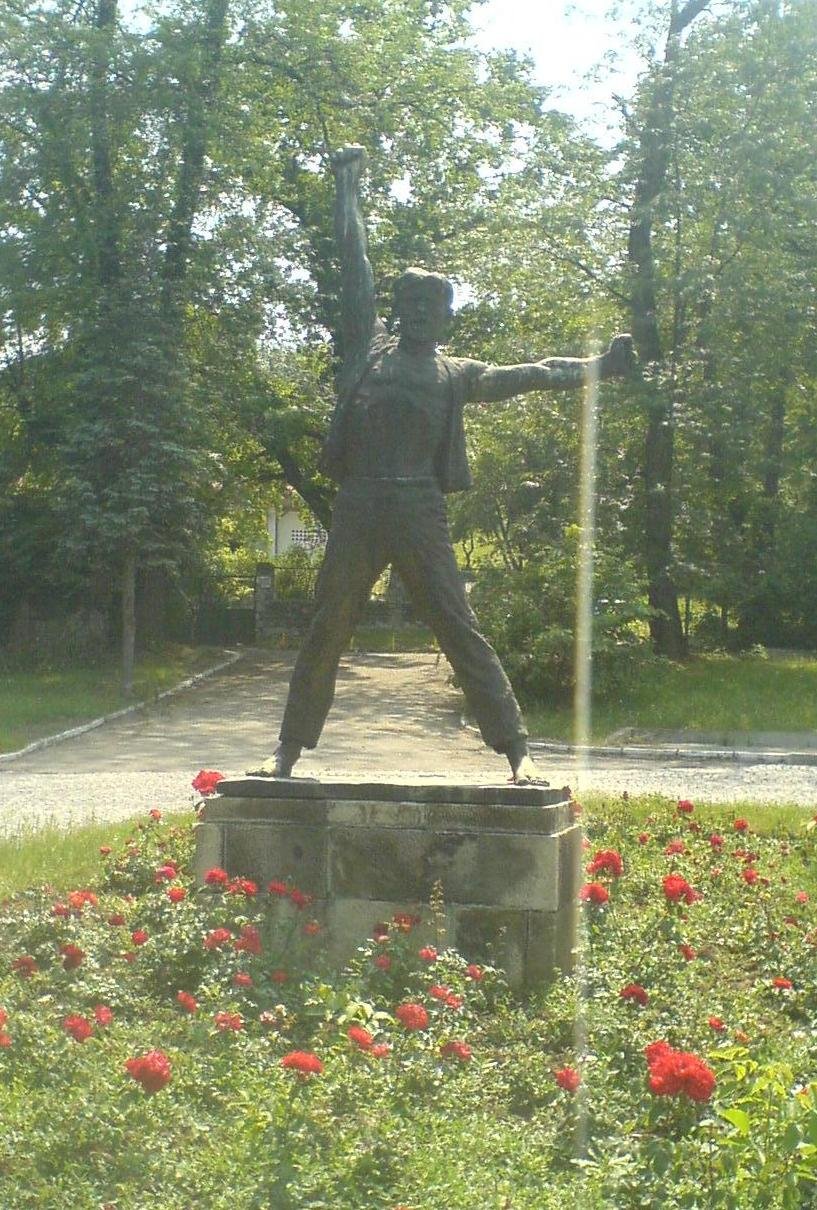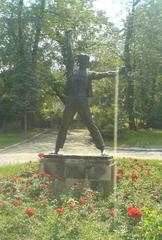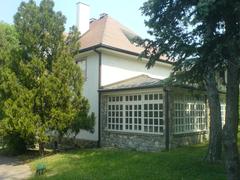
Museum of 4 July Belgrade: Visiting Hours, Tickets, and Comprehensive Guide
Date: 15/06/2025
Introduction
Nestled in the heart of Belgrade, the Museum of 4 July (Muzej 4. juli) is a landmark commemorating a defining event in Yugoslav and Serbian history—the decision on July 4, 1941, to ignite a nationwide anti-fascist uprising against German occupation during World War II. Established in 1950 within a stately villa on Prince Alexander Karađorđević Boulevard, this museum was the very site where the Central Committee of the Communist Party of Yugoslavia resolved to resist the Axis powers—a choice that profoundly shaped the region’s trajectory (Wikipedia).
Though the museum has been closed since 2003 due to property restitution, its building, the “Call of the Uprising” monument by Vojin Bakić, and its enduring legacy continue to be essential elements of Belgrade’s historical landscape. This guide explores the museum’s origins, cultural significance, architectural features, current status, and practical travel tips, as well as recommendations for further exploration of Belgrade’s rich history (Vojin Bakić - Official Art Archive; imus.org.rs; serbia.com).
Table of Contents
- Introduction
- Origins and Historical Context
- Museum’s Role in Socialist Yugoslavia
- Architectural and Artistic Features
- Current Status and Visiting Information
- Nearby Attractions and Travel Tips
- The Museum’s Place in Serbia’s Historical Narrative
- Accessibility and Facilities
- Special Events and Educational Programs
- Practical Visitor Information (Visiting Hours, Tickets, Getting There)
- Museum of Yugoslavia: Essential Visitor Guide
- Frequently Asked Questions (FAQ)
- Summary and Final Thoughts
- References
Origins and Historical Context
The Birth of the Museum
The Museum of 4 July was founded in 1950 in a villa at 10/A Prince Alexander Karađorđević Boulevard, the very place where the Communist Party’s Central Committee convened in 1941 to launch the Yugoslav resistance (Wikipedia). The date—July 4—became known as Fighter’s Day (Dan borca), a major public holiday during Yugoslavia’s socialist era, symbolizing unity and the anti-fascist struggle.
July 4, 1941: The Yugoslav Uprising
The meeting on July 4, 1941, marked the formal beginning of the Yugoslav Partisan movement, led by Josip Broz Tito. This multi-ethnic resistance was both a military and social revolution, ultimately shaping the post-war Socialist Federal Republic of Yugoslavia (imus.org.rs).
Museum’s Role in Socialist Yugoslavia
During the existence of Yugoslavia, the museum was central to commemorations of Fighter’s Day, hosting exhibitions, official ceremonies, and educational events. It displayed artifacts, documents, and testimonies celebrating the Partisan movement and the Communist Party’s leadership. The “Call of the Uprising” monument by Vojin Bakić became a civic symbol, embodying resistance and unity (Vojin Bakić - Official Art Archive).
Architectural and Artistic Features
Housed in an early 20th-century villa, the museum’s significance lies in its historical associations rather than its architectural style. The “Call of the Uprising” monument is the site’s most prominent artistic feature, symbolizing the call to arms that sparked Yugoslavia’s liberation (serbia.com). Inside, the villa preserved original interiors, with exhibition rooms displaying documents, photographs, propaganda posters, and Socialist Realist artworks (stillinbelgrade.com).
Current Status and Visiting Information
Since 2003, the Museum of 4 July has been closed following property restitution to its pre-war owners (Wikipedia). There are no visiting hours or ticket sales. However, the exterior of the building, the commemorative monument, and a memorial plaque remain accessible to the public.
Nearby Attractions and Travel Tips
Although the museum’s interior is closed, several historical sites in Belgrade offer complementary insights:
- Historical Museum of Serbia (imus.org.rs) — Explores Serbia’s history, including World War II and the anti-fascist movement.
- Museum of Yugoslav History (museumofyugoslavia.org.rs) — Focuses on Yugoslav heritage and Tito’s legacy.
- Kalemegdan Fortress — A fortress park with military history exhibits.
- Museum of Contemporary Art — Nearby, for those interested in Yugoslav and Serbian modern art.
The museum site is easily reached by public transport along Prince Alexander Karađorđević Boulevard, by taxi, or on foot from the city center.
The Museum’s Place in Serbia’s Historical Narrative
Shaping Memory and Identity
The Museum of 4 July played a pivotal role in constructing collective memory and national identity, especially during the socialist period (Brilliantio). Its exhibitions promoted the narrative of “Brotherhood and Unity,” reinforcing the legitimacy of the multi-ethnic Yugoslav state (ep.liu.se).
Post-Yugoslav Transformations
With the dissolution of Yugoslavia, the museum’s mission became contested. New national narratives and political realities led to uncertainty about its role, reflecting broader debates about Serbia’s recent history (ep.liu.se). The building now stands as a site of memory, debate, and reflection on Yugoslavia’s complex legacy.
Accessibility and Facilities
Although the museum itself is closed, the monument and exterior are accessible. The original museum, when open, provided wheelchair access and informational materials in multiple languages.
Special Events and Educational Programs
Prior to closure, the museum hosted commemorations, temporary exhibitions, and educational workshops exploring anti-fascist resistance and Yugoslav history. Today, similar programs are offered at the Historical Museum of Serbia and the Museum of Yugoslav History.
Practical Visitor Information
Visiting Hours & Tickets
- Museum of 4 July: Closed since 2003. The monument and exterior are freely accessible at any time.
- Nearby Museums:
- Museum of Yugoslav History: Tuesday–Sunday, 10:00–18:00; closed Mondays. Admission: ~400 RSD (~3.5 EUR), with discounts for students, seniors, and children under seven free (Visit Serbia).
- Museum of Science and Technology, Ethnographic Museum, Natural History Museum: Combo ticket “Museums 4 You” available for 1,440 RSD (~12 EUR), valid for seven days (Visit Serbia).
Getting There
- Public transport: Bus lines along Prince Alexander Karađorđević Boulevard.
- Taxi/Rideshare: Widely available; fares from the city center average 600–900 RSD.
- Parking: Limited street parking; public transport recommended.
Museum of Yugoslavia: Essential Visitor Guide
Overview
The Museum of Yugoslavia, established in 1996, encompasses the House of Flowers (Tito’s mausoleum), the 25 May Museum, and the Old Museum. It provides extensive exhibits on Yugoslav history, Tito’s legacy, and the cultural life of the Balkans.
Address and Access
- 6 Mihaila Mike Jankovića St., Dedinje, Belgrade (Tourist Organization of Belgrade)
Facilities
- Lockers, restrooms, museum shop, café
- Wheelchair-accessible main exhibition spaces
- Guided tours in Serbian and English (advance booking recommended)
Photography
Personal photography is allowed (without flash/tripods). Professional shoots require permission.
Events
Special exhibitions and cultural events are common, especially around major historical dates.
Frequently Asked Questions (FAQ)
Q: Is the Museum of 4 July open to visitors?
A: No, it has been closed since 2003. The exterior and monument remain accessible.
Q: Can I see the “Call of the Uprising” monument?
A: Yes, it is outside the building and open to the public.
Q: Are there tickets or fees for the monument?
A: No, viewing the exterior and monument is free.
Q: Where can I learn more about Yugoslav history in Belgrade?
A: Visit the Historical Museum of Serbia or the Museum of Yugoslav History for extensive exhibitions.
Q: Are guided tours available?
A: Some city tours include the Museum of 4 July’s exterior; check with Belgrade tourism providers.
Q: Is the Museum of Yugoslavia accessible?
A: Yes, main exhibition halls are wheelchair accessible.
Summary and Final Thoughts
The Museum of 4 July embodies a crucial chapter in Balkan history, commemorating the courageous decision that launched the Yugoslav resistance against fascist occupation. While the museum itself is closed, its legacy endures through the preserved villa, the evocative “Call of the Uprising” monument, and the evolving narratives about unity, resistance, and identity (Wikipedia; Vojin Bakić - Official Art Archive; Brilliantio; ep.liu.se).
To further explore these themes, visit the Museum of Yugoslav History and the Historical Museum of Serbia, which offer deep dives into the region’s complex past (imus.org.rs; museumofyugoslavia.org.rs). Although public access to the Museum of 4 July is not available, travelers can appreciate its historical significance and supplement their experience with guided tours, educational programs, and digital resources such as the Audiala app.
Stay updated through official tourism and museum websites to plan a meaningful visit to Belgrade’s historical landmarks, and embrace the opportunity to reflect on resilience and memory in this dynamic city.
References
- Museum of 4 July, Wikipedia
- Historical Museum of Serbia
- Vojin Bakić - Official Art Archive
- Brilliantio
- ep.liu.se
- serbia.com
- stillinbelgrade.com
- Tourist Organization of Belgrade
- Visit Serbia: Museums 4 You
- Museum of Yugoslavia









































































